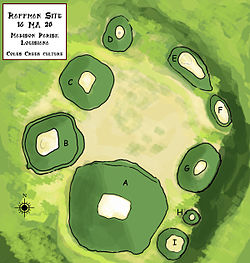 Diagram showing the arrangement of plaza and platform mounds at site | |
| Location | Waverly, Louisiana, Madison Parish, Louisiana, |
|---|---|
| Region | Madison Parish, Louisiana |
| Coordinates | 32°28′23.92″N91°20′46.97″W / 32.4733111°N 91.3463806°W |
| History | |
| Founded | 500 BCE |
| Abandoned | 1200 CE |
| Periods | Balmoral Phase |
| Cultures | Tchefuncte culture, Coles Creek culture |
| Site notes | |
| Excavation dates | 1981, 1998, 2000, 2002, 2004 |
| Archaeologists | Tristram R. Kidder, Lori Roe |
| Responsible body: private | |
The Raffman site ( 16 MA 20 ) is an archaeological site located in Madison Parish, Louisiana and constructed between 700 and 1200 CE. [1] It has components from the Tchefuncte culture and the Coles Creek culture, whose main period of occupation was during the Balmoral phase (1000-1100 CE) of the Tensas Basin and Natchez Bluffs chronology and which was virtually deserted by the end of the Preston phase (1100–1200 CE). [2]

